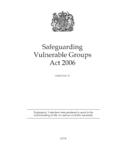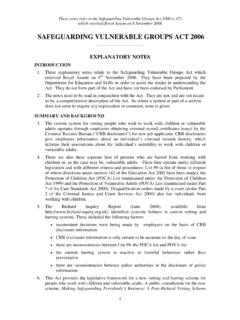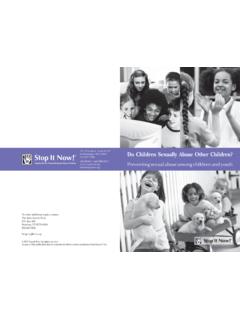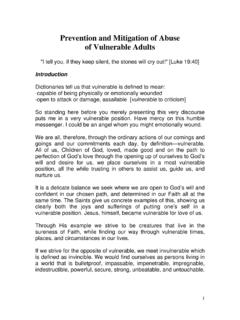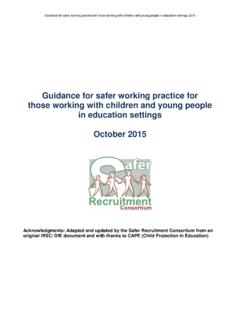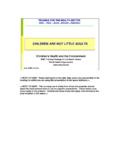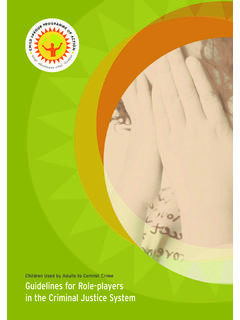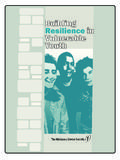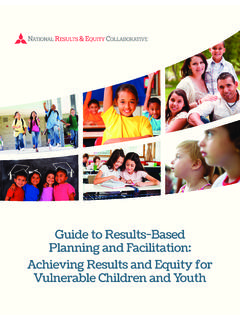Transcription of Module8 Vulnerable Groups - UNHCR
1 Copyright 2005 Reach Out Refugee Protection Training Project Page 1/22 MODULE 8 Vulnerable Groups Summary 1 Learning Objectives 2 Key Messages 2 Preparation 2 Module 8 Breakdown 3 Activity 1 - Identifying Protection Needs Related to Specific Groups 4 Activity 2 - Refugee Child Protection 6 Activity 3 - Protection Concerns for Women 9 Optional Activity 1 - Ella Case Study 11 Optional Activity 2 - Improving Protection for Refugee Women and Children 12 Handout 1 - Protection of Refugees Who Are Elderly, Disabled, or Have HIV/AIDS 13 Trainer Guidance 1 - Activity 2 - Child Protection Sample Feedback 14 Handout 2 - Activity 3 - Statements on Women and Form for Responses 16 Trainer Guidance 2 - Activity 3 - Possible Cmments and Suggestions 18 Handout 3 - Ella Case Study 22 Summary This module emphasises group work to raise awareness and pool the knowledge of the participants on special protection rights and needs related to gender, age, and, if time permits, on disability and health status (such as those refugees with HIV/AIDS who are discriminated against).
2 Through three different group exercises, the participants guide each other in learning about the rights and protection concerns of these refugees, with a focus on children and women. This process of dialogue and discovery is supported by brief overview presentations and access to key learning materials that participants can consult during the training session and that they can use to support their work when they return home. MODULE 8 - Vulnerable Groups INTRODUCTION Copyright 2005 Reach Out Refugee Protection Training Project Page 2/22 Learning Objectives By the end of the session, participants will be able to: Identify different Groups of people who may have specific vulnerabilities; Identify some of the specific protection needs of refugee children, adolescents, and women; Identify some of the specific rights of refugee children and women.
3 Key Messages The rights and protection concerns of all refugees have been specifically acknowledged in a number of national and international laws. There is an abundance of sources to guide humanitarian workers on how to identify and develop responses to the specific protection concerns related to gender, age, and ability or health status; All children have specific protection needs because they are developing physically and emotionally. All children are at risk of sexual exploitation and abuse, which can occur within the family and community; Refugee children face additional protection problems related to the causes and consequences of displacement. Refugee children separated from their parents or primary caregivers need immediate attention and protection; Specific protection problems arise within the female refugee population due to the overwork, deprivation, and exclusion that result from discrimination by all actors, including humanitarian agencies; Programming for those refugees with special protection needs should involve the participation of all parts of the community, and they should support family, community, and other networks of care providers.
4 Programme design needs to be responsive to other daily demands made on women, which may limit their participation. Preparation Read the materials in the optional Gender-Based Violence (GBV) module to ensure that the issues are clear. If GBV issues arise in this session, it would be advisable to defer them until you do the GBV module to avoid repetition of the same messages; Photocopy Handout 2 - Statements on Women and Form for Responses . Note to trainer This module aims to cover an enormous amount of material. It will be your decision to either run this module over a double session or select only the activities you think suitable for your audience and context. MODULE 8 - Vulnerable Groups INTRODUCTION Copyright 2005 Reach Out Refugee Protection Training Project Page 3/22 Module 8 Breakdown Timing Method Resources needed Activity 1 - Identifying Protection Needs Related to Specific Groups Activity 2 - Refugee Child Protection Activity 3 - Protection Concerns for Women Optional activity 1 - Ella Case Study Optional Activity 2 - Improving Protection for Refugee Women and Children 10 40 40 60 40 Total.
5 90 minutes without the optional activities + 100 minutes of optional activities Group exercise Group exercise and presentation Group exercise and presentation Case study Group exercise Coloured post-it notes or coloured paper and tape Handout 1 - Protection of Refugees Who Are Elderly, Disabled, or Have HIV/AIDS Trainer Guidance 1 - Activity 2 - Child Protection Sample Feedback Handout 2 - Statements and Form for Recording Responses Trainer Guidance 2 - Activity 3 - Possible Comments and Suggestions Handout 3 - Ella Case Study Sources The following are sources that relate to the protection of refugee children: Action for the Rights of Children (ARC) training programme put together by Save the Children, the UNHCR , the Office of the High Commissioner for Human Rights, and UNICEF. The training programme is easily accessible on CD-ROM, in PDF and Word format, so users can select and adapt the materials to use as a reference, for training materials, to support project proposals, or to build the capacity and resources of local partners.
6 For more information or to acquire ARC resources, contact ARC Project Co-ordinator, Case Postale 2500, CH-1211 Geneva 2 Depot, Switzerland. See Rachel Hodgkin and Peter Newell, Implementation Handbook for the Convention on the Rights of the Child, UNICEF, 2002. See, especially, Chapter 22 on refugee children. Celia Petty, Mary Tamplin, and Sarah Uppard, Working with Separated Children: Field guide, training manual and training exercises, Save the Children, 1999. The following are sources that relate to the protection of refugee women: Guidelines on the Protection of Refugee Women, Office of the United Nations High Commissioner for Refugees, Geneva 1991. Protecting Refugees: A Field Guide for NGOs, Office of the United Nations High Commissioner for Refugees, Geneva 1999. See the sections Protecting Refugee Women and Protecting Refugee Children and Adolescents.
7 Susan Forbes Martin, Refugee Women, Zed Books, 1991. The following is a source that relates to human rights and disability: Gerard Quinn and Theresia Degener, Human rights and Disability: The current use and future potential of United Nations human rights instruments in the context of disability, Office of the United Nations High Commissioner for Human Rights, Geneva 2002. MODULE 8 - Vulnerable Groups ACTIVITY 1 Copyright 2005 Reach Out Refugee Protection Training Project Page 4/22 Activity 1 - Identifying Protection Needs Related to Specific Groups Timing Method Resources needed Group exercise Brainstorming 5 5 Total: 10 minutes Group exercise Brainstorming in plenary Handout 1 - Protection of Refugees Who Are Elderly, Disabled, or Have HIV/AIDS Note to trainer Make this a snappy exercise, as it is designed mainly to provide the link between the protection needs of all Vulnerable Groups (such as the elderly, people living with HIV/AIDS, ethnic minorities, etc.)
8 And protection needs relating specifically to women and children. If you feel there will be sensitivities regarding age, then ask the group to line up in order of birth months, with January at the front of the line and December at the end. Group exercise (5 minutes) Ask the group to line up in order of the year of their birth, with the oldest at one end of the line and the youngest at the other end. Once the group has formed a line, split them into smaller Groups . You want to be left with six small Groups , so the number in each group will depend on the total number of participants. Give each group one of the following identities: Elderly; Children; Women; Survivors of violence; People with physical or mental disabilities; Ethnic minorities. Ask each group to answer the following question from their identity perspective: What are your expectations of NGOs to provide for your specific protection needs?
9 Allow Groups five minutes to discuss. Brainstorming (5 minutes) Ask each group what their specific expectations include. You may look for some of the following issues, although this list is not exhaustive, and expect many more issues to arise: Elderly (someone to carry their food and water, access to health care, access to a community centre); Children (education, play areas, reunification services); MODULE 8 - Vulnerable Groups ACTIVITY 1 Copyright 2005 Reach Out Refugee Protection Training Project Page 5/22 Women (physical safety, access to post-natal care, to be near water and fuel, opportunities for income-generating activities); Survivors of violence (access to counselling, specific health-care support); People with physical or mental disabilities (access to specific health care, activities with the community to support integration).
10 Ethnic minorities (physical safety, representation, appropriate opportunities to practise faith or culturally based activities). Explain that, whilst there is a myriad of Groups that have specific protection concerns, women and children are the largest (approximately 80 per cent) Groups , which is why this module concentrates on the specific protection needs of refugee women and children and their entitlements under international law. If you think it is appropriate, distribute Handout 1 - Protection of Refugees Who Are Elderly, Disabled, or Have HIV/AIDS . MODULE 8 - Vulnerable Groups ACTIVITY 2 Copyright 2005 Reach Out Refugee Protection Training Project Page 6/22 Activity 2 - Refugee Child Protection Timing Method Resources needed Group exercise Feedback Presentation on child protection 20 10 10 Total: 40 minutes Group exercise Plenary Slide presentation Coloured post-it notes or coloured paper and tape Trainer Guidance 1 - Activity 2 - Child Protection Sample Feedback Note to trainer This session relates to children.










